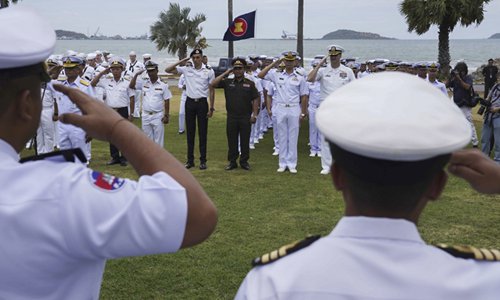
US Navy officers and maritime forces from Association of Southeast Asian Nations (ASEAN) member states saluting during the opening ceremony for the ASEAN-US Maritime Exercise at Sattahip Naval Base, Chonburi province, Thailand on Monday. Photo: AFP
The US on Monday launched its first joint naval exercise with the Association of Southeast Asian Nations (ASEAN) - the ASEAN-US Maritime Exercise. US Rear Admiral Kenneth Whitesell spoke at the opening ceremony of the exercise. He said that Washington has been promoting to counter China's increasing influence in Asia, including Beijing's territorial claims in the South China Sea.
We need to be highly vigilant that the US is using the joint naval exercise to add military pressure on China in the South China Sea. As we are taking necessary measures to guard against US military provocation, we need to make it clear to neighboring countries: bonding with the US force to infringe on Chinese territorial integrity will only make regional conditions more complicated and harm the common security of Southeast Asia.
The maritime exercise shows that the US is still a dominant force in Southeast Asia. Washington is going to further target Beijing and strengthen its military presence in the region. The maritime exercise is part of the US' Indo-Pacific Strategy, and an important part of strategy toward China.
Southeast Asian countries are close neighbors of China. Perhaps ASEAN members do not hope to turn the joint naval exercise into a collective action against China, but the US obviously wants the world to see it that way. Since all 10 members participated in the exercise, we still cannot underestimate the US influence on ASEAN.
However, China's relations with Southeast Asian countries have made remarkable progress, especially economic and trade relations. According to China's State Council Information Office in July, ASEAN has surpassed the US to become China's second-largest trading partner in the first half of 2019.
Through such economic cooperation, China plans to gradually reach a consensus with Southeast Asian countries and thus form the basis for negotiations over maritime disputes. This could have been a peaceful and mutually beneficial way to resolve the disputes.
But the US has been preventing the win-win cooperation between China and Southeast Asian countries. The US is working harder to intervene in regional affairs and undermine China's influence in Southeast Asia, trying to maintain US hegemony worldwide. By selling arms to Taiwan and strengthening its military presence in the South China Sea, the US has already become aggressive rather than defensive. This has greatly increased the risks in the region.
Will Southeast Asian countries eventually be forced to choose sides? Yes, unfortunately, although Southeast Asian countries have tried to carefully deal with their relations with China and the US, the US is forcing these countries to make a choice.
China is not afraid of US provocation. We have enough strength to defend our core interests. But how can China provide reliable security protection to regional countries? This will be a challenge for China, unless China replaces the US in security sphere and sets up a new collective security mechanism in Southeast Asia.

